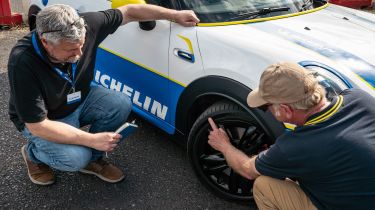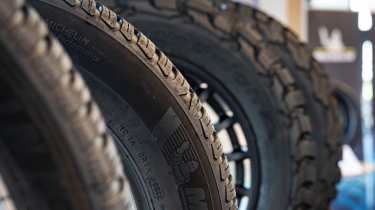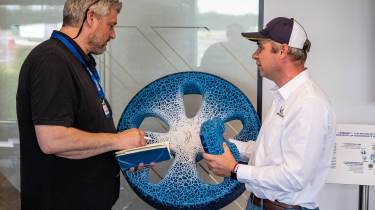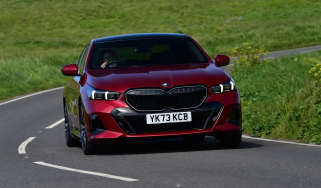Half of drivers think a new pair of tyres should go on the car's front wheels, but they're wrong
New tyres must go on the rear axle, with part-worn treads moved to the front - whether the car is FWD, RWD or 4x4

Up to half of UK drivers – and more worryingly, a significant proportion of the tyre trade – don’t know whether to put new tyres on the front or back of cars, potentially putting themselves and others at risk.
That’s the verdict of Michelin UK’s technical manager Brian Porteous, who told Auto Express that tyre trade and garage staff, plus workshop and fleet managers, are asked the question before participating in the firm’s periodic safety demonstrations – just like the one Michelin invited Auto Express to take part in recently at the Horiba MIRA test track.
“We have tyre technicians, depot managers, people involved in fleets, and I’d say it’s 50:50,” says Porteous, in relation to views expressed as to whether new pairs of tyres should go on the back or the front of a vehicle.
“The ones who get it wrong have a belief based on what they think are reasons related to the braking or traction of a vehicle,” he adds. “But industry advice is that it’s most important to keep the vehicle stable in a straight line, because that’s where the risk is greatest.”
In case you are wondering, that industry advice says new tyres, or those in the newest condition, should always be fitted at the rear of a vehicle, and not at the front. The same guidance covers cars with front-wheel drive, rear-wheel drive and four-wheel drive layouts, and for the vast majority of vehicles on the road, Michelin’s demonstration proves the evidence is clear cut. Having participated in the demo ourselves, we think it would be foolhardy to ignore the guidance.
“Once the vehicle is stable, then you can start thinking about braking and traction,” says Porteous. “And what you actually find is there is sufficient braking and traction from the part-worn tyres at the front. We’re not talking about ‘worn out’ tyres, so they still have a level of capability. If they’re insufficient for braking and traction,” he adds, “then of course the fronts should be replaced as well”.
What about RWD or 4x4 cars?
And in case you were wondering whether different rules apply for different powertrain layouts such as front-wheel drive (FWD), rear-wheel drive (RWD) or 4x4, Michelin’s top technical expert is keen to point out that the ‘new rubber on the rears’ advice remains exactly the same.
“FWD, RWD and 4x4 all respond in a similar way at the limit of lateral adhesion,” he says.” I have demonstrated the same thing using powerful 4x4 SUVs. Once sliding, the characteristics and the requirements of the driver to regain stability differ slightly between the different vehicles, but the advice to maintain the best grip at the rear to avoid the possibility of oversteer and lift off oversteer remains the same for all.
“This is also important for vehicles with different front and rear tyre sizes,” Porteous adds. “In such cases the advice in the owners handbook for the car should be followed to maintain the recommended maximum differences between front and rear tread depths. Of course the action of moving rear tyres to the front also means that the wear life of those tyres is optimised, rather than them perhaps being removed from the rear axle owing to age, but with tread wear left.”

To demonstrate just what ‘stability’ means in the context of tyre position, for our test Michelin laid on three identical Volkswagen Golfs equipped with its popular Cross Climate tyres; one had new tyres fitted incorrectly at the front, with rears shaved down to 2.6mm of tread, while another had new rubber fitted to the rears with the worn 2.6mm treads up front, as per the guidance. A third Golf had worn tyres on three corners, and a brand new tyre fitted to just the right-hand front wheel.
“Car manufacturers design their vehicles with gentle understeer,” explains Porteous. “It’s a condition that a driver can understand quickly, and an instinctive response to slow down brings the situation under control.
“That’s why we advise fitting tyres with the best grip at the rear, because then the tyres will always generate that same understeering condition, and will be working with the car to deliver a safe, predictable response.”
We drove all three cars on the wet-handling circle at MIRA, which features a very low-friction concrete surface that, in effect, magnifies handling effects. In other words, things happen at 20mph that might otherwise take you by surprise at 50-70mph on an A-road or slip-road.
We tried the car with new tyres at the rear first, and the Golf behaved impeccably, with the nose slipping gently wide as speed increased, but coming immediately back into line as the driver backed off the throttle. Next up was the car with new tyres at the front – against the guidance – and the difference was potentially terrifying. The car’s innate stability had disappeared, and gently increasing speed caused the back end to break away sharply into oversteer as rear-end traction was lost. It was easy to catch on the test track but at higher speeds out on the road, with the car having drifted sideways, it might have been an altogether deadlier story.
“Oversteer is unpredictable, and most drivers are not trained to understand it. They may experience it first in a moment of panic, for example swerving to avoid someone stepping off a curb, or a car coming out of a junction,” he says.
Trying the third car fitted with just one new tyre on the right front was even more revealing, and arguably the most alarming scenario. Turning right, the car was inherently stable as the evenly worn left-hand tyres held traction until the car’s nose drifted wide into gentle understeer, easily controlled by lifting off the throttle.
Turning left, however, was a different story. The new front tyre gripped better than the worn rear, launching the car into oversteer. As Porteous pointed out, in this scenario, even the corrections become unpredictable; lifting off the throttle corrects the understeer when turning right, but the same driver response could worsen the effect of oversteer when turning left.
The lessons to be learned are obvious. Regardless of what you may be told by a garage, tyre fitter or even your company-car fleet manager, any new tyres must go on the rear axle with partly worn treads moved to the front. As Porteous told us: “That’s what I tell my family, and my advice to anyone else would be to insist on it.”
Michelin and the future of tyre tech

The Michelin brothers got their start in the tyre business after patenting a removable pneumatic bicycle tyre in 1891, and were the first company to offer similar pneumatic tyres for motor cars. We’ve been riding on air ever since, paying the price for the smoother ride with the risk of punctures.
Michelin, which claims to spend more on research and development than the rest of the global tyre industry combined, is continuing its quest to eliminate that risk through a possible return to solid tyres. Its latest concept, the Vision, is a 3D-printed composite wheel and tyre you replace in one go when needed, which takes that idea to its logical conclusion. It’s a fantasy for now, but Michelin already sells its one-piece airless Tweel for use on construction sites, while its Uptis solid tyre is undergoing trials on passenger vehicles.
“Vision is a concept, a pole star for Michelin,” spokesman James Dimmock told us at MIRA. “It’s where we’re heading – the idea of a product that’s sustainably produced from bio or recycled materials. It’s got real-time sensors, and when you wear the tread out, you 3D-print a new one.
“Working back with products like Uptis and Tweel, you can see how we’re developing. I’d love to say it’s what we’re going to do and be driving in the future, but our investment in R&D means we are at the forefront, trying to create the product of tomorrow,” he said.
Click here for our guide on how to check tyre age...




